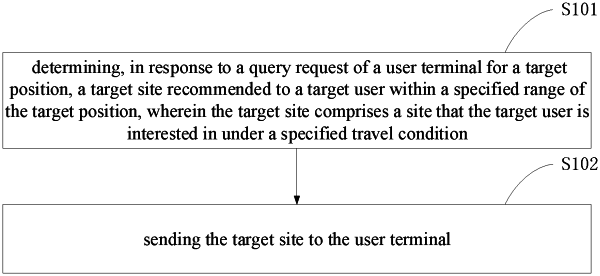| CPC G06F 16/9537 (2019.01) [G06F 16/9535 (2019.01); G06F 16/9538 (2019.01)] | 15 Claims |

|
1. A computer-implemented site recommendation method, comprising:
determining, in response to a query request of a user terminal for a target position, a specified travel condition and a target site recommended to a target user within a specified range of the target position, wherein the target position comprises a current position of the target user positioned by the user terminal based on a positioning system, the target site comprises a site that the target user is interested in under the specified travel condition, and the target site is a site determined from one or more sites that the target user is interested in and is matched with the specified travel condition; and
sending the target site to the user terminal,
wherein determining the specified travel condition comprises:
obtaining a user portrait of the target user and a travel scenario corresponding to the query request; wherein the travel scenario comprises at least one of: a travel time of the target user, and an area type of an area to which the target position belongs;
determining a usual travel mode of the target user based on the user portrait; and
determining the usual travel mode of the target user and the travel scenario corresponding to the query request as the specified travel condition,
wherein determining the specified range comprises: determining, based on the usual travel mode, a specified range corresponding to the usual travel mode,
wherein determining the target site recommended to the target user within the specified range of the target position, comprises:
recalling candidate sites that the target user is interested in, under the specified travel condition, by using at least one pre-selected recall strategy;
sorting the candidate sites to obtain a sorting result; and
determining the target site according to the sorting result,
wherein the sorting the candidate sites to obtain the sorting result, comprises:
inputting the candidate sites into a trained sorting model, to obtain the target site;
wherein the trained sorting model is a sorting model trained based on a pre-constructed positive sample set and a pre-constructed negative sample set, the positive sample set is a sample set constructed based on a pair of sites in which a secondary transformation behavior occurs in a pre-divided time period, and the negative sample set is a sample set constructed based on a pair of sites in which the secondary transformation behavior does not occur in the pre-divided time period,
wherein the secondary transformation behavior comprises a behavior of initiating a navigation.
|